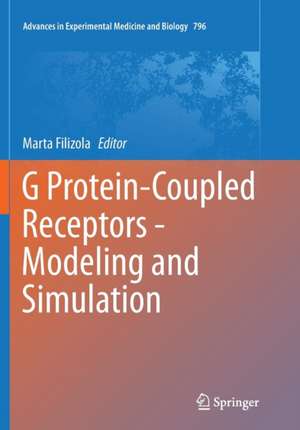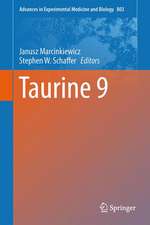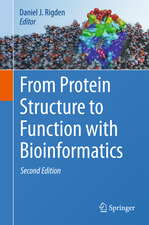G Protein-Coupled Receptors - Modeling and Simulation: Advances in Experimental Medicine and Biology, cartea 796
Editat de Marta Filizolaen Limba Engleză Paperback – 23 aug 2016
| Toate formatele și edițiile | Preț | Express |
|---|---|---|
| Paperback (1) | 944.51 lei 6-8 săpt. | |
| SPRINGER NETHERLANDS – 23 aug 2016 | 944.51 lei 6-8 săpt. | |
| Hardback (1) | 954.45 lei 6-8 săpt. | |
| SPRINGER NETHERLANDS – 11 noi 2013 | 954.45 lei 6-8 săpt. |
Din seria Advances in Experimental Medicine and Biology
- 9%
 Preț: 719.56 lei
Preț: 719.56 lei - 5%
 Preț: 717.00 lei
Preț: 717.00 lei - 5%
 Preț: 717.00 lei
Preț: 717.00 lei - 15%
 Preț: 640.24 lei
Preț: 640.24 lei - 5%
 Preț: 715.71 lei
Preț: 715.71 lei - 5%
 Preț: 716.28 lei
Preț: 716.28 lei - 20%
 Preț: 691.93 lei
Preț: 691.93 lei - 5%
 Preț: 1031.00 lei
Preț: 1031.00 lei - 5%
 Preț: 820.42 lei
Preț: 820.42 lei - 5%
 Preț: 716.28 lei
Preț: 716.28 lei - 15%
 Preț: 641.38 lei
Preț: 641.38 lei - 5%
 Preț: 717.20 lei
Preț: 717.20 lei - 5%
 Preț: 715.35 lei
Preț: 715.35 lei - 5%
 Preț: 1113.83 lei
Preț: 1113.83 lei - 20%
 Preț: 1161.71 lei
Preț: 1161.71 lei - 5%
 Preț: 1170.51 lei
Preț: 1170.51 lei - 18%
 Preț: 1119.87 lei
Preț: 1119.87 lei - 5%
 Preț: 1288.48 lei
Preț: 1288.48 lei - 5%
 Preț: 1164.67 lei
Preț: 1164.67 lei - 5%
 Preț: 1101.73 lei
Preț: 1101.73 lei - 18%
 Preț: 1123.67 lei
Preț: 1123.67 lei - 5%
 Preț: 1435.64 lei
Preț: 1435.64 lei - 20%
 Preț: 1044.10 lei
Preț: 1044.10 lei - 18%
 Preț: 946.39 lei
Preț: 946.39 lei - 5%
 Preț: 292.57 lei
Preț: 292.57 lei - 18%
 Preț: 957.62 lei
Preț: 957.62 lei - 18%
 Preț: 1235.76 lei
Preț: 1235.76 lei - 5%
 Preț: 1231.55 lei
Preț: 1231.55 lei - 5%
 Preț: 1292.30 lei
Preț: 1292.30 lei - 5%
 Preț: 1102.10 lei
Preț: 1102.10 lei - 18%
 Preț: 1132.81 lei
Preț: 1132.81 lei - 5%
 Preț: 1165.19 lei
Preț: 1165.19 lei - 5%
 Preț: 1418.48 lei
Preț: 1418.48 lei - 5%
 Preț: 1305.63 lei
Preț: 1305.63 lei - 18%
 Preț: 1417.72 lei
Preț: 1417.72 lei - 18%
 Preț: 1412.99 lei
Preț: 1412.99 lei - 24%
 Preț: 806.15 lei
Preț: 806.15 lei - 18%
 Preț: 1243.29 lei
Preț: 1243.29 lei - 5%
 Preț: 1429.44 lei
Preț: 1429.44 lei - 5%
 Preț: 1618.70 lei
Preț: 1618.70 lei - 5%
 Preț: 1305.12 lei
Preț: 1305.12 lei - 18%
 Preț: 1124.92 lei
Preț: 1124.92 lei - 5%
 Preț: 1097.54 lei
Preț: 1097.54 lei - 15%
 Preț: 649.87 lei
Preț: 649.87 lei - 5%
 Preț: 1097.54 lei
Preț: 1097.54 lei - 18%
 Preț: 945.79 lei
Preț: 945.79 lei - 5%
 Preț: 1123.13 lei
Preț: 1123.13 lei - 20%
 Preț: 816.43 lei
Preț: 816.43 lei
Preț: 944.51 lei
Preț vechi: 1151.84 lei
-18% Nou
Puncte Express: 1417
Preț estimativ în valută:
180.73€ • 189.18$ • 150.43£
180.73€ • 189.18$ • 150.43£
Carte tipărită la comandă
Livrare economică 31 martie-14 aprilie
Preluare comenzi: 021 569.72.76
Specificații
ISBN-13: 9789402402582
ISBN-10: 9402402586
Pagini: 236
Ilustrații: VIII, 228 p. 59 illus., 45 illus. in color.
Dimensiuni: 178 x 254 x 12 mm
Greutate: 0.42 kg
Ediția:Softcover reprint of the original 1st ed. 2014
Editura: SPRINGER NETHERLANDS
Colecția Springer
Seria Advances in Experimental Medicine and Biology
Locul publicării:Dordrecht, Netherlands
ISBN-10: 9402402586
Pagini: 236
Ilustrații: VIII, 228 p. 59 illus., 45 illus. in color.
Dimensiuni: 178 x 254 x 12 mm
Greutate: 0.42 kg
Ediția:Softcover reprint of the original 1st ed. 2014
Editura: SPRINGER NETHERLANDS
Colecția Springer
Seria Advances in Experimental Medicine and Biology
Locul publicării:Dordrecht, Netherlands
Cuprins
Preface. Section I Progress in Structural Modeling of GPCRs.- The GPCR Crystallography Boom: Providing an Invaluable Source of Structural Information and Expanding the Scope of Homology Modeling.- Modeling of G Protein-Coupled Receptors Using Crystal Structures: From Monomers to Signaling Complexes. Section II. GPCRs in Motion: Insights from Simulations.- Structure and Dynamics of G Protein-Coupled Receptors.- How the Dynamic Properties and Functional Mechanisms of GPCRs are Modulated by their Coupling to the Membrane Environment.- Coarse-Grained Molecular Dynamics Provides Insight into the Interactions of Lipids and Cholesterol with Rhodopsin.- Beyond Standard Molecular Dynamics: Investigating the Molecular Mechanisms of G Protein-Coupled Receptors with Enhanced Molecular Dynamics Methods. Section III. GPCR-Focused Rational Design and Mathematical Modeling.- From Three-Dimensional GPCR Structure to Rational Ligand Discovery.- Mathematical Modeling Of G Protein-Coupled Receptor Function: What Can We Learn From Empirical And Mechanistic Models? Section IV. Bioinformatics Tools and Resources for GPCRs.- GPCRs & Company: Databases and Servers for GPCRs and Interacting Partners.- Bioinformatics Tools for Predicting GPCR Gene Functions. Index.
Textul de pe ultima copertă
G protein-coupled receptors (GPCRs) are heptahelical transmembrane receptors that convert extra-cellular stimuli into intra-cellular signaling, and ultimately into biological responses. Since GPCRs are natural targets for approximately 40% of all modern medicines, it is not surprising that they have been the subject of intense research. Notwithstanding the amount of data generated over the years, discovering ligands of these receptors with optimal therapeutic properties is not straightforward and has certainly been hampered for years by the lack of high-resolution structural information about these receptors. Luckily, there has been a steady increase of high-resolution crystal structures of these receptors since 2007, and this information, integrated with dynamic inferences from computational and experimental methods, holds great potential for the discovery of new, improved drugs.
This book, which provides, for the first time, state-of-the-art views on modeling and simulation of GPCRs, is divided into 4 parts. In the first part, the impact of currently available GPCR crystal structures on structural modeling is discussed extensively as are critical insights from simulations in the second part of the book. The third part reports recent progress in rational ligand discovery and mathematical modeling, whereas the fourth part provides an overview of bioinformatics tools and resources that are available for GPCRs.
This book, which provides, for the first time, state-of-the-art views on modeling and simulation of GPCRs, is divided into 4 parts. In the first part, the impact of currently available GPCR crystal structures on structural modeling is discussed extensively as are critical insights from simulations in the second part of the book. The third part reports recent progress in rational ligand discovery and mathematical modeling, whereas the fourth part provides an overview of bioinformatics tools and resources that are available for GPCRs.
Caracteristici
This book is unique in its sort The GPCR field is fast evolving, and computational techniques such as those described in this book, are becoming more and more utilized Includes state-of-the-art views on modeling and simulation by recognized experts with an established reputation in the development and/or application of computational methods to GPCRs

























